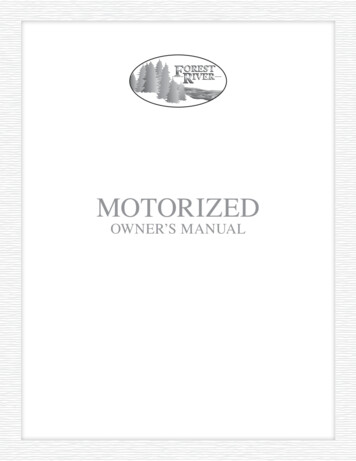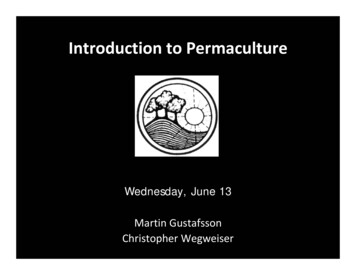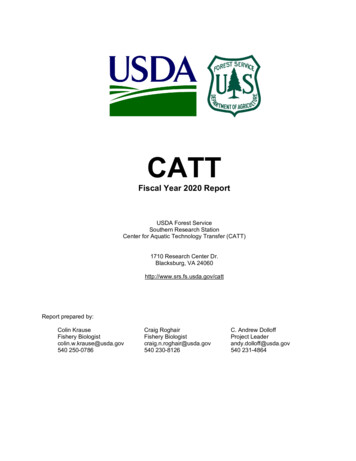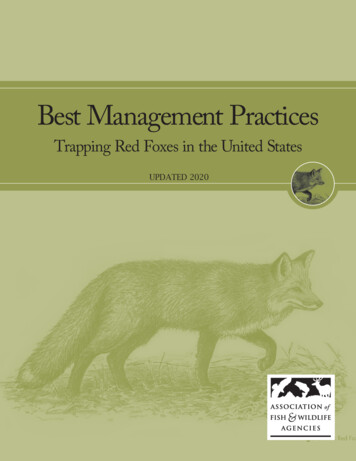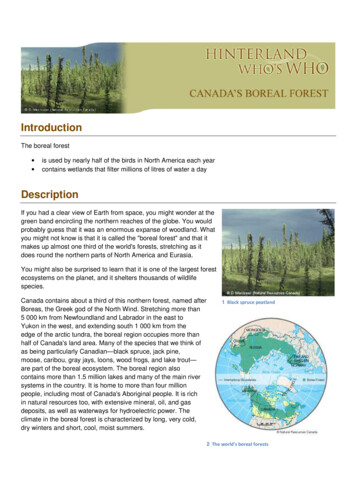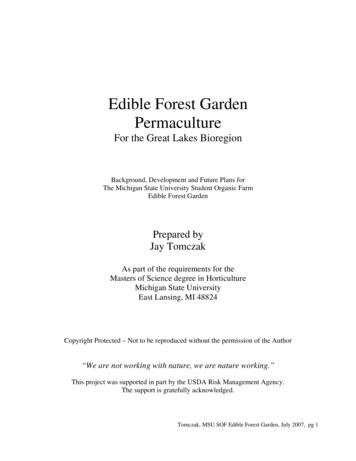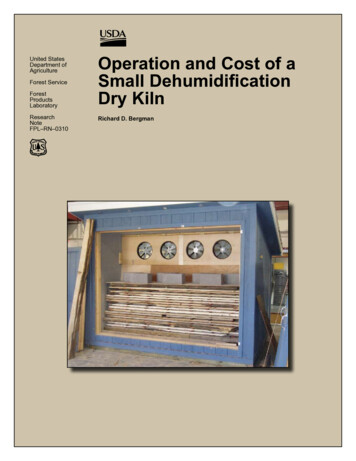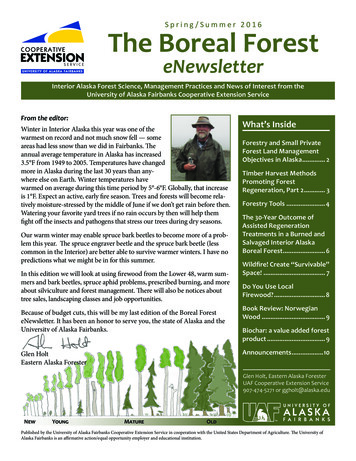
Transcription
Spring/Summer 2016The Boreal ForesteNewsletterInterior Alaska Forest Science, Management Practices and News of Interest from theUniversity of Alaska Fairbanks Cooperative Extension ServiceFrom the editor:Winter in Interior Alaska this year was one of thewarmest on record and not much snow fell — someareas had less snow than we did in Fairbanks. Theannual average temperature in Alaska has increased3.5 F from 1949 to 2005. Temperatures have changedmore in Alaska during the last 30 years than anywhere else on Earth. Winter temperatures havewarmed on average during this time period by 5 -6 F. Globally, that increaseis 1 F. Expect an active, early fire season. Trees and forests will become relatively moisture-stressed by the middle of June if we don’t get rain before then.Watering your favorite yard trees if no rain occurs by then will help themfight off the insects and pathogens that stress our trees during dry seasons.Our warm winter may enable spruce bark beetles to become more of a problem this year. The spruce engraver beetle and the spruce bark beetle (lesscommon in the Interior) are better able to survive warmer winters. I have nopredictions what we might be in for this summer.In this edition we will look at using firewood from the Lower 48, warm summers and bark beetles, spruce aphid problems, prescribed burning, and moreabout silviculture and forest management. There will also be notices abouttree sales, landscaping classes and job opportunities.Because of budget cuts, this will be my last edition of the Boreal ForesteNewsletter. It has been an honor to serve you, the state of Alaska and theUniversity of Alaska Fairbanks.What’s InsideForestry and Small PrivateForest Land ManagementObjectives in Alaska. 2Timber Harvest MethodsPromoting ForestRegeneration, Part 2. 3Forestry Tools. 4The 30-Year Outcome ofAssisted RegenerationTreatments in a Burned andSalvaged Interior AlaskaBoreal Forest. 6Wildfire! Create “Survivable”Space!. 7Do You Use LocalFirewood?. 8Book Review: NorwegianWood . 9Biochar: a value added forestproduct. 9Announcements.10Glen HoltEastern Alaska ForesterGlen Holt, Eastern Alaska ForesterUAF Cooperative Extension Service907-474-5271 or ggholt@alaska.eduNewYoungMatureOldPublished by the University of Alaska Fairbanks Cooperative Extension Service in cooperation with the United States Department of Agriculture. The University ofAlaska Fairbanks is an affirmative action/equal opportunity employer and educational institution.
The Boreal Forest eNewsletterForestry and Small Private ForestLand Management Objectives inAlaskaGlen Holt, Eastern Alaska forester, UAF CooperativeExtension ServiceMany Alaskans own forest land or live on a treed lotbecause they appreciate a woodland setting. Increasingly, Alaskans are interested in what they can do tomanage their forest for a variety of reasons. Many areinterested in maintaining or improving their forest tomeet a variety of individual goals.Forestry is defined by the Society of American Foresters (SAF) Web Dictionary as the science and craft ofcreating, managing, using, conserving and repairingforests and associated resources to meet desired goals,needs and values for human benefits. The science offorestry has elements that belong to the biological,physical, social, political and managerial sciences.Wikipedia goes on to say that modern forestry embraces a broad range of concerns that encompassmultiple-use management, including the provisionof timber for wood products and revenue, fuel wood,wildlife habitat, water quality, recreation, landscapeand community protection, employment opportunities, aesthetically appealing landscapes, biodiversity,watershed management, erosion control, fire andwind protection, protection from insect infestationsand, lately, preserving forests as “sinks” for atmospheric carbon dioxide. A practitioner of forestry isknown as a forester. A forester may specialize in anumber of areas listed above.Forest management is defined by the SAF as a branchof forestry concerned with overall administrative,economic, legal, social, scientific and technical aspects. Some of those include silviculture, protection,enhancement, rehabilitation, restoration and forestregulation.Land is often owned as a hedge against inflation.Some own forestland to facilitate increased monetaryopportunity with an eye to the future. Most small private forest landowners in Alaska are less interested inproducing a timber crop than they are in improvingother attributes.2Spring/Summer 2016Small forest landowner objectivesmay include anarray of personalinterests includingpersonal space,privacy, peace andquiet, personaluse timber andfirewood, foresthealth, wildlifehabitat, waterquality, biodiversity, aesthetics,recreation and trails, wildfire defensible space, berriesand other wild edibles, subsistence resources and acombination of opportunities. Often people in Alaskaare interested in what they can do to improve theirforest, for themselves, their children and their grandchildren.Forest improvement may include the use of a chainsaw to harvest poor trees or create wildfire defensiblespace and the use of a shovel to plant additional treesfor the future. We will present and discuss severalmeans and methods of tending your small privateforested ownership in future newsletters.The University of Alaska Fairbanks Cooperative Extension Service Field Forestry Program partners and cooperates with other agencies, organizationsand the private sector to address forest-related needs and questions posedby the public. Extension forestry is currently working with the State Divisionof Forestry, the USDA Forest Service, the Bureau of Land Management, theAlaska Department of Fish and Game, the USDA Natural Resource Conservation Service, various Soil and Water Conservation districts, a number of private non-government organizations, the Fairbanks North Star Borough, UAFaffiliates, rural development organizations, community groups and others toprovide information about the management, biology and social interests relating to Alaska boreal forest through workshops, newspaper articles, radioand television interviews and more.
The Boreal Forest eNewsletterSpring/Summer 2016Timber Harvest Methods PromotingForest Regeneration, Part TwoOther considerations might include aesthetics, windprotection and/or a lack of sufficient market to justifycutting those trees left in the forest.Glen Holt, Eastern Alaska forester, UAF CooperativeExtension ServiceIn the Fall/Winter 2015 issue we outlined harvestmethods that promote an even-aged forest.A more even-aged forest regenerates naturally aftera disturbance such as a wildfire. Most trees die aftera hot wildfire or are killed or die shortly thereafterbecause of the injuries they suffered or from insectinfestations or wind throw. This kind of natural disturbance may often be many thousands of acres. Treespecies that by their biology require full sunlight togrow best are at an advantage in this situation.The fire-regenerated forest begins regrowing withtree species that require full sunlight. These thousands of regrowing seedlings quickly compete forsunlight, moisture, nutrients and growing space. Theyare in a race for the light at this stage, and as saplingscrowd each other, those that can’t compete quicklyget shaded out and die.Sun-loving or shade-intolerant tree species in Interior and Southcentral Alaska include birch, aspen,balsam poplar and cottonwood. Certain willowspecies are important for wildlife browse. Willow isalso shade-intolerant and grows best in full sunlight.Sufficient soil moisture and warmer soil temperaturesfacilitate regeneration after fires on good sites.Even-aged harvest methods try to mimic wildfire orevents such as avalanches and soil deposition fromriver bend deposits and, as described in the last issue,clearcuts, seed tree cuts and shelter wood cuts.Uneven-aged forest management methodsThe Selective Cut Method — The selection harvestor partial harvest method is used to promote an uneven-aged forest that has several age and size classes.The use of this method may be to promote the growthof trees that prefer or can tolerate partial shade and/or provide for other forest attributes, such as diversewildlife habitats, watershed protection and excessivesnow melt to maintain soil site moisture and attributes of habitat for wildlife that prefer a mix of foresttypes, including the older growth forest type.This method works in Interior Alaska when managing uneven aged white spruce stands. Selectiveharvesting works best when accompanied by promptsite preparation methods to expose mineral soil sothat spruce seeds (if any) may germinate or plantedspruce seedlings may be free to grow while not degrading the residual forest.Site preparation for natural regeneration or treeplanting is best applied during or immediately afterharvest so the area isn’t taken over by grass or shrubcompetition. The intent is to maximize seedling establishment and survival.“High grading” may be confused with selective harvesting, which is intended to diversify tree age andsize classes through additional successful regeneration. Anything that resembles high grading is basically “mining” the forest and fails to take into consideration the future condition of the residual forest or itsability to regenerate. High grading maximizes profitsby taking the highest quality timber with little regardfor what is left uncut. A selective cut that does nothing to improve forest stand condition or regenerationis of little future value.Poorly formed trees left in the stand have littlechance of improving once the best are cut. A harvestplan to selectively cut the poorly formed trees, forexample, for firewood, hopes and plans that the goodtrees left over will improve or retain their value andthat their seed and genetic traits will be passed on inthe form of healthy regeneration. Harvests of this nature must rely on successful regeneration and assumethat new seedlings and small trees will be in locationsthat won’t be significantly impacted by additionalfuture harvesting.A modification of the selective cut called the groupselection method has been shown to be a biologicallysustainable silvicultural system for western hemlock-Sitka spruce forests in Southeast Alaska wherethe intent is to maintain current tree species in an uneven-aged composition and structure on a long-term3
The Boreal Forest eNewsletterSpring/Summer 2016basis. Often this less economically feasible harvestmay benefit winter range habitat for Sitka blacktailed deer, which are important for subsistence.Forestry ToolsThe best scenario is that selective harvesting improves healthy trees in all age classes. Improperlyapplied, this method looks like a “cull tree release”and the forest is devalued economically for manyyears in the future.Adapted from an article, photos and drawings by SteveNix, About-Forestry.comTimber stand outcome must be anticipated to determine whether the forest will successfully regenerateunder any of these harvest methods. Using the selective or single-tree harvest method, the landownershould decide whether the small trees left in the forest are sufficiently undamaged after harvest and arearranged in such a way as to benefit from the extrasunlight without undue grass or brush competition.Scarification to expose mineral soil might be a goodidea prior to harvesting if possible in those locationswhere access is not relegated to winter only.I encourage all of you interested in forest management to Google “about forestry,” which will lead toforestry.about.com and many excellent articles written by forestry expert Steve Nix.Using a Biltmore or Cruiser Stick toDetermine Tree and Log VolumesThe Biltmore stick, or cruiser stick, is a tool usedin cruising and measuring trees and logs to estimatetheir lumber volume. It is a useful part of a timberowner’s toolkit and can be purchased at any forestrysupply center, or you can get instructions to makeyour own.The Biltmore stick is a straight wooden stick, similarin appearance to a yard stick but graduated for directreadings of tree diameters and heights. The stick allows you to measure tree diameter at a point 4½ feetabove stump height (DBH) and also the merchantableheight in terms of 16-foot logs from a distance of 66feet. With these two measurements, the board footvolume of the tree may be determined. The volumetable is actually printed on the stick.ReferencesNix, S. 2015. “Tree Harvesting Methods That Encourage Forest Regeneration: The Major Natural and Artificial Reforestation Schemes,” mThe Biltmore, or cruiser, stickHere is the step-by-step process of using a Biltmorestick to determine tree height, diameter and total merchantable volume.How to measure tree diameter with aBiltmore stickStand squarely in front of the tree and hold the stickface flat against tree horizontally at right angles toyour line of sight. Hold the stick against the tree atDBH (a spot 4½ feet above the stump height) and 25inches from the observer’s eye. The stick is also 25inches so you can determine that distance from youreye to the tree. Read the diameter directly from the“diameter of tree” side of the stick.4
The Boreal Forest eNewsletterSpring/Summer 2016To measure merchantable tree height stand 66 feet(approximately 12 paces) from the tree you want tomeasure. Hold the stick in the upright vertical position 25 inches from your eye with the “number of16-foot logs” side of the stick facing you. Usually thisis on an edge of the stick.Biltmore stick DBH drawing from the USFS-NC StateThe user’s perspective is compensated for by the DBHgraduations (inch marks get shorter as tree diameterincreases) making it possible to measure a 40-inchdiameter tree. Most commercially purchased Biltmoresticks are calibrated for using at a distance of 25 inches from the eye.Because of the difficulty maintaining exact distanceand keeping the stick in the absolute vertical or horizontal, the stick must be regarded as a fairly crudemeasuring device. It is handy for quick estimates butnot generally used by foresters for generating precisecruise data.The number of logs can be read directly off the stickstarting upward from the estimated stump height.You are not actually measuring total height but areestimating 16-foot log sections. With this merchantable height estimated in logs, plus the diameter, youcan estimate tree volume.You can also estimate the total height of the tree bycounting each 16-foot length and adding them together for a total height. Every total tree height willnot come to an even log. Prorate the last log into feetby using a proportional estimate. Volume may beestimated using the DBH and the total tree height onanother volume table obtained locally from the stateforestry area office.To measure tree volume, hold the Biltmore sticksquarely against the tree at DBH and 25 inches fromyour eye.How to measure Tree Merchantable Height Shift stick to right or left side of the tree until the zero,or left, end of the volume side of the stick lines upwith a Biltmore StickMerchantable height refers to the lengths of usablelogs and is measured from stump height to the cutoffpoint in the top. That height may be 9, 6 or 4 inchesfrom the top, depending on the product intended andon the number of tree limbs.with the left edge of the tree. Sighting the right side ofthe stick where it touches outside bark (only movingyour eyes) gives you the diameter on the top line andbelow this the number of board feet for trees of different numbers of logs. The tree in the picture aboveappears to be 16 inches DBH. Don’t move your headto read the DBH, just your eyes.Let’s say you measure a 16-inch-diameter tree at DBHthat has three 16-foot logs. If you have a Scribner logscale Biltmore stick, you would calculate that the treehas approximately 226 board feet of merchantabletimber in it. To accurately measure lengths and diameters, you must hold the stick in the exact vertical orhorizontal positions.Biltmore stick tree height USFS-NC StateTo measure volume of logs on the ground, positionthe “log diameter” scale across the small end of thelog by placing the stick across the place that appearsto be average diameter (or take several readings and5
The Boreal Forest eNewsletteraverage). Log volumes for different diameters andlengths from 8 to 16 feet can be read on the flat side ofthe stick marked “log scale”.If you have a 16-foot log that averaged 16 inches onthe small end, looking at the log scale where thesenumbers correspond you would read 159 board feetScribner Scale for that log.Logs over 16 feet long are scaled as two logs, allowing for taper on logs 22 feet or longer. A 20-foot log,for example, 15 inches in diameter, would be scaledas two 10-foot logs, each 15 inches in diameter.A Biltmore stick is a helpful tool to determine grossrough estimates of tree and log volume. Percent defect may need to be deducted to determine an estimate of merchantable volume.UAF School of Natural Resources andExtension Forest Science ResearchThe 30-Year Outcome of AssistedRegeneration Treatments in a Burnedand Salvaged Interior Alaska BorealForestAndrew Allaby, M.S. Candidate Research at UAFSchool of Natural Resources and Extension. Edited byGlen Holt, Eastern Alaska forester, UAF CooperativeExtension ServiceForestry practices to improve forest regeneration, including site preparation (scarification) to expose mineral soil and planting or direct seeding, were evaluated on certain test sites. These practices were carriedout immediately after a timber harvest or wildfire.The early effects of these practices are presumed topersist throughout a timber stand’s lifetime.Timber salvage after a fire has been increasing in theAlaska boreal forest, creating the need to evaluate itseffect on forest regeneration.Samples were taken in an operational-scale whitespruce regeneration trial in a productive upland forestafter a 1983 wildfire and subsequent timber harvest.6Spring/Summer 2016Regeneration treatments were applied on two landform types, four ground scarification treatments (toexpose mineral soil for tree seed germination) anda non-scarified control plot, and five artificial whitespruce regeneration treatments (planting) plus a natural seed fall control plot were measured and compared.Total biomass was analyzed as well as how manysquare feet of solid wood was present for all treespecies in order to evaluate the persistence of regeneration treatment effects after 28 growing seasons. Inthis research, ground scarification treatments weredetermined to have had no significant effect on whitespruce size or amount of wood. However, when compared to natural seed fall control plots, white sprucedensity was found to be six times higher in plantedseedling plots, and white spruce stem density wasfound to be nearly three times greater in plots thatwere direct seeded.White spruce stem density from natural seed fall averaged 2,360 stems/acre. This stem density was dependent on both topographic position of the site measured and distance to wind-dispersed seed sources.Scarification nearly doubled Alaska birch stem density and square feet of wood compared to non-scarifiedcontrol plots. Planted white spruce plots supported 19percent fewer square feet of solid birch wood, except in the most intensive scarification treatments inwhich birch did not differ.Although quaking aspen density and the square feetof wood were generally unaffected by the regenerationforestry practices in this study, intensive scarificationreduced wood density by half on sloping plots.These results confirm that forest regeneration practices continue to influence stand development beyondthe tree/stem initiation stage. However, practices thatpromote one species may reduce others.
The Boreal Forest eNewsletterSpring/Summer 2016and working to maintain it each year, assess yourproperty for its ability to resist wildfire when no onehas yet arrived to suppress it.An aerial image of the Rosie Creek reforestation study areaplotsWildfire! Create “Survivable” Space!Anything that can catch fire on or near your homeshould be removed so your structures don’t ignitefrom a cloud of hot burning embers. Check yourproperty, home, buildings, wood piles and vehicles,etc., for their ability to resist burning embers or directimpingement by flames. Is your woodpile so closeit will catch your home on fire? Are your home andporch skirted so embers and fire can’t burn beneaththem? Are your fuel tanks, gas cans, ATV or snowmobile, extra vehicles, lumber piles, patches of drygrass or other things that could catch fire too close toyour home and other structures?Glen Holt, Eastern Alaska forester, UAF CooperativeExtension Service, was formerly a fire prevention officerwith the laska Division of Forestry and worked as awildland firefighter for 29 years.Last year wildfires burned more than 5 million acresin Alaska. Carelessness with burn piles and burnbarrels and sparks from power tools occurred duringhot, dry conditions and caused wildfires that burnedout of control.Creating and maintaining defensible space so firefighters have a chance of suppressing fire is important.It is also critical to think in terms of creating andmaintaining our own “survivable space” if wildfiresbecome so large that they thwart initial suppressionefforts.No one who has ever gone through the ravages ofwildfire has considered themselves, in the aftermath,to have been totally prepared for the losses theysuffered. Each year, evaluate your home owner’s fireinsurance policy. Make sure your coverage adequatelyreflects the losses you’d incur if fire burned your homeor property tomorrow.Begin to think in terms of “survivable space”. Askyourself, if a wildfire becomes so large firefighterscan’t protect me, will I survive the occurrence? Oftenfires can grow beyond the local wildfire resources’ability to control them. After creating defensible spaceThis home near Willow, Alaska survived the Coho Fire in 2015because nothing on or around it could catch fire.Windborne burning embers are the leading causeof wildfire spread. Determine if your property andpossessions can survive a virtual cloud of hot embersfalling on them as a wind-driven wildfire approaches.Following are some suggestions on how tosurvive a wildfire:Move all flammable vegetation at least 30 feet awayfrom your home and other structures. Make a borderaround your home and buildings of four feet or morewith gravel. Move everything flammable 30 or morefeet away from structures. If a wildfire is in the area,cover gable and eve vents with fine metal screening.Block in beneath your porch so embers can’t blowthere. Clean out or remove your gutters. Keep your7
The Boreal Forest eNewslettergrass cut short around structures. Water your homeand surroundings with a hose or sprinkler before thefire gets there or the power goes out.Contact the Alaska Division of Forestry or yourlocal Fire Department and ask them for a wildfireFIREWISE evaluation. Maintain defensible space.Find out what else you can do to prevent wildfirefrom destroying your property.For more information on how you can create andmaintain defensible space go to the Alaska State Forestry’s ts and other Forest ProblemsDo You Use Local Firewood?Adapted from a poster publication by the USDA ForestService, Liz GrahamAlaska, with its majestic landscapes, is home to morethan 120 million acres of our nation’s forests. Withendless trees in the Interior and towering rain forestsalong the coast, it seems strange to many Alaskansthat firewood is being brought or transported fromoutside. But every year firewood makes its way toAlaska, and it often brings unwelcome visitors alongwith it.Tree killing pests can live inside firewoodfor years.Tree-killing insectsand diseases canlurk in firewood.These insects anddiseases can’t movefar on their own,but when peoplemove firewood theycan jump hundredsof miles. Alaska ispartially protected by geographic isolation. Butbecause we have so8Spring/Summer 2016few species of trees,the introduction of asingle exotic pest coulddramatically changeour landscape andlifestyles. Imagine yourcommunity withoutbirch or spruce trees.Chestnut blight andDutch elm diseaseare two examples of exotic pests that have virtuallyeliminated their entire host species from America’slandscape.Firewood movement is a well-established source ofspreading insects and disease. Each year visitors bringfirewood with them when camping, and commercialfirewood bundles are brought from out of state by thepallet. It is illegal to transport firewood to or fromCanada unless it has been heat-treated and inspected.Commercial firewood from other states should betreated the same. But as many as half of tested firewood samples transported harbor living wood borersor bark beetles. The Alaska Division of Agriculturehas captured living insects in firewood from as faraway as Oklahoma.Our forests are threatened by invasivetree-killing insects and diseases.Alaska has seen large swaths of forest killed by ournative bark beetles in the past. However, nativetrees have defenses against the insects and diseasesthat they’ve been living with for thousands of years.Non-native insects and diseases have no predatorsin their new homes, and the trees have no naturaldefenses against them.Want to know more? Contact Liz Graham, entomologist, eegraham@fs.fed.us.
The Boreal Forest eNewsletterSpring/Summer 2016Book ReviewForest Products CornerNorwegian Wood: Chopping,Stacking, and Drying Wood theScandinavian Way by Lars MyttingBiochar: a value-added forest productA condensed book review by Peter Lewis found inBARNESANDNOBLEREVIEW.COMBiochar is a form of charcoal used historically foragriculture and soil enhancement. It is not the charcoal used in the hibachi. Biochar is most often beingused as a soil amendment by organic farmers. Reportsindicate some South American cultures used biocharfor intensive agriculture as long as 8,000 B.C. on soilsthat to this day are more fertile than surroundinglocal jungle soils.In his new book, Norwegian Wood, Lars Myttingmixes the practical with the art and science of burning firewood from a cultural European, Norwegianperspective.“The woodcutter who attunes himself to the ways ofnature and the passing seasons will quickly find hisreward. The annual growth cycle of trees means thatthe best time to fell them is in the winter or spring,well before the leaves have started to bud.” Myttingcontinues, “One of firewood’s most attractive qualitiesis that it burns up and disappears.”There are chapters on the subjectivity of the choppingblock and the evolution of the wood stove and a special section, wisely given its own space, of “cold facts.”Sections in the book deal with the environmentalsoundness of wood burning (managed properly,argues Mytting, it is a carbon-neutral renewable); theamount of Btus by species; comparative weights percord; and drying rates depending upon the characterof the stack of wood. There is also information onchainsaws, axes, peaveys and bow saws.Norwegian Wood is currently available in Fairbanks atthe Woodway and Gulliver’s Books.Glen Holt, Eastern Alaska forester, UAF CooperativeExtension ServiceBiochar feedstock processing methods and soil characteristics determine the soil’s chemistry and howbiochar can be used to enhance soil capabilities. Thesefactors determine biochar’s effectiveness when compared to the use of modern fertilizers and other soilenhancers. Soil organics is an important factor in thesoil’s ability to hold water, increase nutrient availability and improve microbial and fungal populations.Organic farmers are interested in biochar as a way toenhance soil without chemical fertilizers.Biochar is also being used and tested as a form of“activated charcoal” to bind and absorb toxins introduced into soil systems from pollutants.Ongoing, present-day research is focusing on biochar’s benefits in soil water retention and its abilityto make natural soil nutrients and those from fertilizer more available over time. Fertility enhancementwould be of considerable interest in the far northwhere colder soils make nutrient uptake, even withfertilization, situationally problematic.Biochar could be obtained and produced as an additional value-added product made from low-value,renewable feedstock, including waste wood andbyproducts from other timber products made in themanufacture of lumber, pellets, etc.Many people are also interested in biochar production and use as a means to sequester carbon.Biochar was historically produced in covered pitsdug into the ground, in large open piles and in bee9
The Boreal Forest eNewsletterhive-style kilns. These systems are inefficient andlabor intensive and create significant smoke particulate pollution. Modern technology is computerizedand heats the feedstock quickly to a temperature atwhich uncombusted gases are driven off and thenreturned to the combustion chamber, providing anongoing fuel source for additional combustion for theremainder of the burn. The fuel and air mixture mustbe carefully controlled to minimize smoke particulatepollution and maximize biochar production.Biochar can be produced during the production ofcharcoal by further grinding the size of extra or poorly formed briquettes into the small pieces preferredwhen using biochar for soil enhancement or toxinremediation.Spring/Summer 2016AnnouncementsTree Give-Away at Fort WainwrightFort Wainwright will have a tree seedling give-awayand a tree planting on Arbor Day, Friday, May 13.The seedling give-away will be at the EnvironmentalBuilding 3023 from 10 a.m. to 2 p.m. Tree planti
and other wild edibles, subsistence resources and a combination of opportunities. Often people in Alaska are interested in what they can do to improve their forest, for themselves, their children and their grand-children. Forest improvement may include the use of a chain-saw to harvest poor trees or create wildfire defensible



